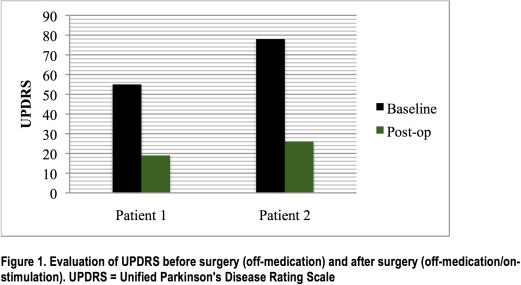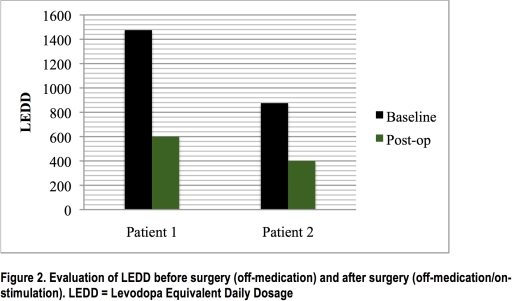Session Information
Date: Monday, June 20, 2016
Session Title: Surgical therapy: Parkinson's disease
Session Time: 12:30pm-2:00pm
Location: Exhibit Hall located in Hall B, Level 2
Objective: The aim of our study was to evaluate prospectively the changes in motor, nonmotor symptoms (NMS) and quality of life produced by subthalamic deep brain stimulation (STN-DBS) in patients with Parkin mutation.
Background: There are a few studies reporting the effects of DBS in genetic parkinsonism. STN-DBS has been shown to successfully improve symptoms in autosomal recessive parkinsonism associated with Parkin (Park2; OMIM 602544). However, the available studies have focused mainly on the effects of DBS in motor function. To date, the outcomes of DBS on the different Parkinson’s disease (PD) patients NMS have not been characterized, as well as the long-term effect on their quality of life, leaving several clinically relevant questions unanswered.
Methods: Two cousins with juvenile Park2 mutations and refractory motor symptoms were screened for STN-DBS (patient 1, 44-years-old, male, disease duration = 30 years; patient 2, 36-years-old, female, disease duration = 24 years). The patients were evaluated before and 1 year after surgery. The primary outcome was change in motor function after surgery. Secondary outcome measures were changes in quality of life and NMS including cognitive and psychiatry function, pain, sleep, and autonomic disturbances assessed by specific scales and questionnaires.
Results: One year after surgery there was a clinically relevant improvement in motor features with a reduction of 65% and 66% in UPDRS part III in ”off medication/on-stimulation”  and a complete abolition of peak dose dyskinesias. The levodopa equivalent dosage also decreased
and a complete abolition of peak dose dyskinesias. The levodopa equivalent dosage also decreased  . The nonmotor (NMSS total score) decreased significantly after surgery, excepted for the urinary symptoms which worsened in both patients. The Hospital Anxiety and Depression Scale and quality of life improved as well
. The nonmotor (NMSS total score) decreased significantly after surgery, excepted for the urinary symptoms which worsened in both patients. The Hospital Anxiety and Depression Scale and quality of life improved as well
| Patient 1 | Patient 2 | |||||
| Data | Baseline | STN-DBS 12 months | Change (%) | Baseline | STN-DBS 12 months | Change (%) |
| Non-motor symptoms scale | ||||||
| Cardiovascular | 6 | 3 | 50 | 5 | 1 | 80 |
| Sleep/ Fatigue | 23 | 5 | 78 | 16 | 2 | 87 |
| Mood/ Cognition | 20 | 0 | 100 | 6 | 0 | 100 |
| Perceptual problems | 4 | 0 | 100 | 0 | 0 | N |
| Attention/ Memory | 6 | 0 | 100 | 0 | 0 | N |
| Gastrointestinal tract | 2 | 0 | 100 | 20 | 20 | N |
| Urinary function | 2 | 6 | [dagger] | 0 | 4 | [dagger] |
| Sexual function | 3 | 0 | 100 | 0 | 0 | N |
| Miscellaneous | 13 | 6 | 53 | 12 | 0 | 100 |
| Total Score | 79 | 20 | 74 | 68 | 27 | 60 |
| Hospital Anxiety Scale | 8 | 4 | 50 | 8 | 5 | 37 |
| Hospital Depression Scale | 6 | 2 | 66 | 6 | 3 | 50 |
| Visual Analogic Pain Scale | 2 | 0 | 100 | 10 | 0 | 100 |
| SF-36 Quality of Life Questionnaire | 481 | 556 | 15 | 281 | 706 | 151 |
Conclusions: Patients with Park-2 mutations may benefit from subthalamic nucleus deep brain stimulation. Our findings showed that, in addition to the improvement in the motor symptoms, the STN-DBS also improved the majority of nonmotor symptoms, which could affect negatively their quality of life. We hypothesized that clinical phenotype rather genotype is the main predictor for DBS outcome.
To cite this abstract in AMA style:
L.M. Oliveira, R.G. Cury, H.F. Chien, J.G. Santos, M.G. Ghilardi, R.B. Machado, E.T. Fonoff, B.R. Egberto. Effects of subthalamic deep brain stimulation in motor and nonmotor function in Parkinson’s disease patients with parkin mutation [abstract]. Mov Disord. 2016; 31 (suppl 2). https://www.mdsabstracts.org/abstract/effects-of-subthalamic-deep-brain-stimulation-in-motor-and-nonmotor-function-in-parkinsons-disease-patients-with-parkin-mutation/. Accessed April 21, 2025.« Back to 2016 International Congress
MDS Abstracts - https://www.mdsabstracts.org/abstract/effects-of-subthalamic-deep-brain-stimulation-in-motor-and-nonmotor-function-in-parkinsons-disease-patients-with-parkin-mutation/
